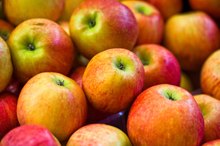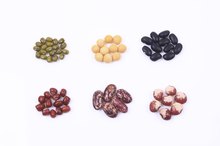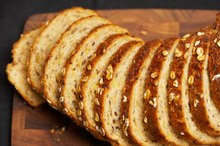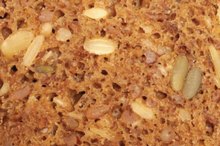What does fact checked mean?
At Healthfully, we strive to deliver objective content that is accurate and up-to-date. Our team periodically reviews articles in order to ensure content quality. The sources cited below consist of evidence from peer-reviewed journals, prominent medical organizations, academic associations, and government data.
- Harvard School of Public Health: Carbohydrates and Blood Sugar
- Harvard Health Publications: Glycemic Index and Glycemic Load for 100+ Foods
The information contained on this site is for informational purposes only, and should not be used as a substitute for the advice of a professional health care provider. Please check with the appropriate physician regarding health questions and concerns. Although we strive to deliver accurate and up-to-date information, no guarantee to that effect is made.
Rice Flour & Blood Sugar
All carbohydrate foods have some sort of effect on your blood sugar -- some more than others. Both white and brown rice flour will raise your blood sugar, but white rice is likely to have a larger effect because it has been refined and is lower in fiber 4. If you're managing diabetes or trying to stabilize your blood sugar for all-day energy, it's helpful to know exactly how rice flour will affect it.
Carbs and Blood Sugar
Of all three macronutrients -- protein, fat and carbohydrates -- carbs are the one with the biggest effect on blood sugar 2. Carbs come from foods like bread, pasta, rice, beans, milk and fruits and vegetables. After you eat carbs, your body breaks them down in to sugars, which are then absorbed into the bloodstream and supply your body with energy. Simple carbohydrates in foods like cake, candy and cookies, as well as fruit, milk and refined grains, are broken down quickly and have a more immediate effect on blood sugar; complex carbs from whole grains and vegetables are digested more slowly and have a more mild impact on blood sugar 2.
Brown Rice vs. White Rice
What Food Groups Are Carbohydrates Found in?
Learn More
Whole grains have a lesser effect on blood sugar than refined grains because they have more fiber and are digested more slowly. Brown rice is a whole grain, while white rice is not. During processing, the bran and germ -- and most of the fiber -- are removed from white rice, leaving only the starchy endosperm. Brown rice, on the other hand, retains all parts of the grain and is a good source of fiber. This difference is key to understanding the different effects of white and brown rice flour on blood sugar 4.
- Whole grains have a lesser effect on blood sugar than refined grains because they have more fiber and are digested more slowly.
- Brown rice, on the other hand, retains all parts of the grain and is a good source of fiber.
Rice and the Glycemic Index
The glycemic index is a measurement of how a particular carbohydrate food affects blood sugar. The higher the rating, the more the food spikes your blood sugar. On a scale of one to 100, foods with a glycemic index below 55 are considered low glycemic; foods with a glycemic index of 56 to 69 are medium glycemic, and those with a rating of 70 to 100 are high glycemic. Brown rice has a glycemic index of 50, while white rice has a much higher glycemic index of 89.
- The glycemic index is a measurement of how a particular carbohydrate food affects blood sugar.
- On a scale of one to 100, foods with a glycemic index below 55 are considered low glycemic; foods with a glycemic index of 56 to 69 are medium glycemic, and those with a rating of 70 to 100 are high glycemic.
Using Rice Flour
What Diabetics Eat to Get Energy
Learn More
If you follow a gluten-free diet, rice flour is a handy alternative to wheat flour. Choose brown rice flour whenever possible to minimize blood sugar fluctuations, which can lead to low energy and moodiness 4. You can use brown rice flour as a substitute for wheat flour in baked goods and pasta, as a thickener for sauces and as a coating for fish and chicken 4.
Related Articles
References
- Joy Bauer: Refined Grains: How Food Affects Health
- Harvard School of Public Health: Carbohydrates and Blood Sugar
- Harvard Health Publications: Glycemic Index and Glycemic Load for 100+ Foods
- Bob's Red Mill: Brown Rice Flour
- Rice, white, short-grain, enriched, cooked. FoodData Central. U.S. Department of Agriculture. Published April 1, 2019.
- Rice, brown, cooked. FoodData Central. U.S. Department of Agriculture. Published April 1, 2019.
- Roy P, Orikasa T, Okadome H, Nakamura N, Shiina T. Processing conditions, rice properties, health and environment. Int J Environ Res Public Health. 2011;8(6):1957-76. doi:10.3390/ijerph8061957
- Fung KY, Cosgrove L, Lockett T, Head R, Topping DL. A review of the potential mechanisms for the lowering of colorectal oncogenesis by butyrate. Br J Nutr. 2012;108(5):820-31. doi:10.1017/s0007114512001948
- Harris KA, Kris-Etherton PM. Effects of whole grains on coronary heart disease risk. Curr Atheroscler Rep. 2010;12(6):368-76. doi:10.1007/s11883-010-0136-1
- Cermak NM, van Loon LJ. The use of carbohydrates during exercise as an ergogenic aid. Sports Med. 2013;43(11):1139-55. doi:10.1007/s40279-013-0079-0
- Jeon YH, Oh SJ, Yang HJ, Lee SY, Pyun BY. Identification of major rice allergen and their clinical significance in children. Korean J Pediatr. 2011;54(10):414-21. doi:10.3345/kjp.2011.54.10.414
- Nowak-Węgrzyn A, Chehade M, Groetch ME, et al. International consensus guidelines for the diagnosis and management of food protein-induced enterocolitis syndrome: Executive summary-Workgroup Report of the Adverse Reactions to Foods Committee, American Academy of Allergy, Asthma & Immunology. J Allergy Clin Immunol. 2017;139(4):1111-1126.e4. doi:10.1016/j.jaci.2016.12.966
- Qian Y, Chen C, Zhang Q, Li Y, Chen Z, Li M. Concentrations of cadmium, lead, mercury and arsenic in Chinese market milled rice and associated population health risk. Food Control. 2010;21(12):1757-1763. doi:10.1016/j.foodcont.2010.08.005
- Havenaar R. Intestinal health functions of colonic microbial metabolites: a review. Benef Microbes. 2011;2(2):103-14. doi:10.3920/bm2011.0003
- Labensky SR, Hause AM, Martel P. On Cooking: a Textbook of Culinary Fundamentals. Boston: Pearson; 2015.
Writer Bio
Jody Braverman is a professional writer and editor based in Atlanta, GA. She received a Bachelor of Arts in English from the University of Maryland, and she is a certified personal trainer, fitness nutrition specialist, and yoga teacher. She has written for various online and print publications, including Livestrong.com, SFGate, Healthfully, and Chron.com. Visit the writer at www.JodyBraverman.com.








